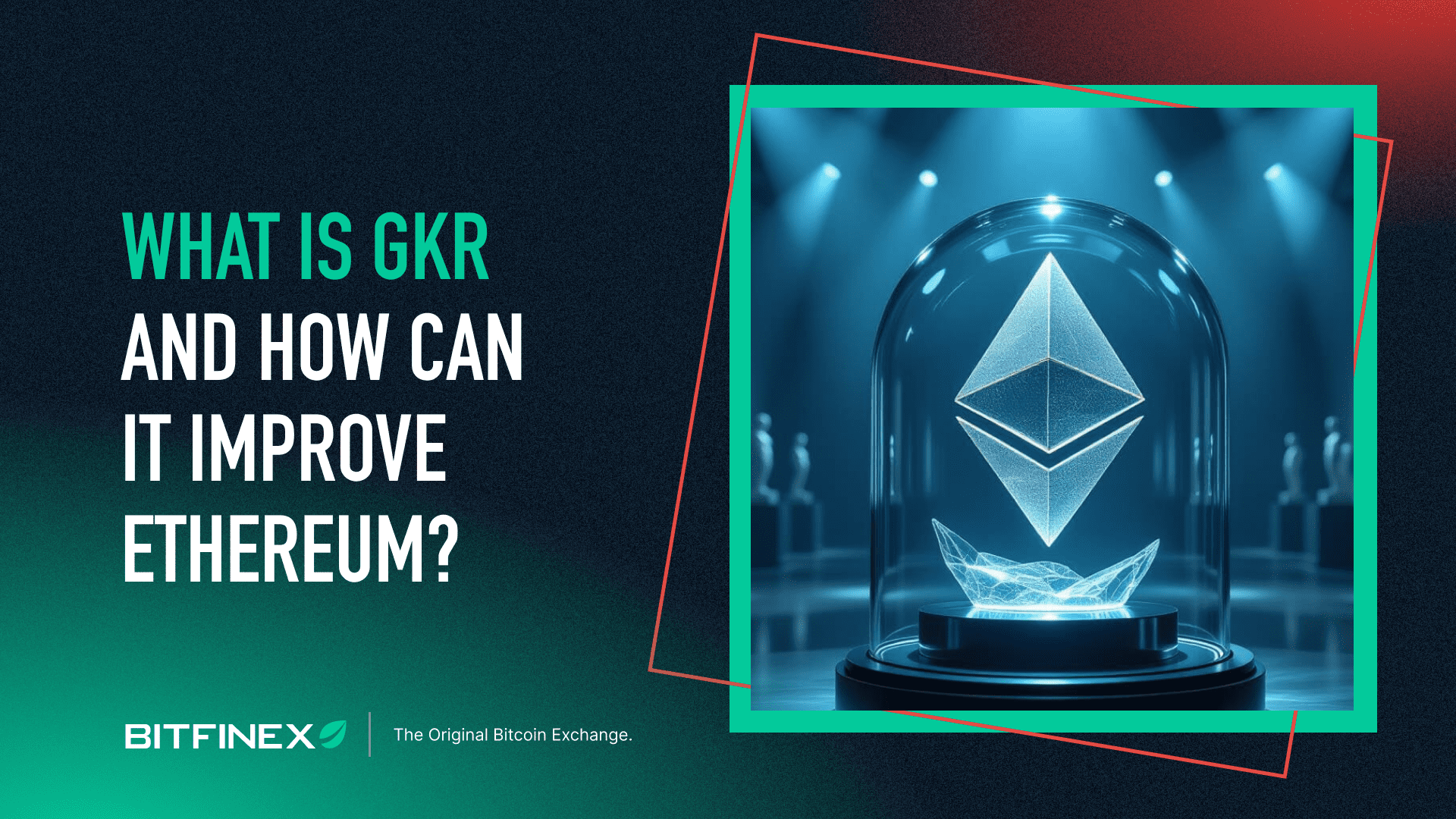
27 Oct What is GKR and How Can it Improve Ethereum?
GKR (Goldwasser–Kalai–Rothblum) proofs are an advanced cryptographic proving method designed to make complex computations faster and more efficient by verifying only the inputs and outputs of a process rather than every intermediate step. Using recursive “sumcheck” reductions, GKR significantly reduces prover overhead compared to traditional proof systems such as STARKs or FRI, providing succinct and cost-effective verification without inherently offering privacy, though it can be combined with SNARKs or STARKs for zero-knowledge functionality. For Ethereum, GKR holds major potential to improve scalability, particularly for rollups and zkEVMs, by lowering proof generation costs, accelerating verification, and enabling more frequent, smaller proof submissions. Its efficiency could enhance user experience, reduce transaction fees, and expand Ethereum’s capacity for advanced cryptographic applications like verifiable AI and private computation. However, GKR’s benefits depend on implementation quality and the structure of the workloads it is applied to, meaning practical performance gains will require careful optimisation. If successfully integrated, GKR could become a cornerstone of Ethereum’s push toward a more scalable, secure, and cryptographically verifiable network
What are GKR Proofs?
GKR (Goldwasser–Kalai–Rothblum) is a family of interactive proving techniques tailored to computations that look like “many inputs flowing through many layers,” such as batched hash functions or neural-network–style pipelines. Its core optimisation is structural: instead of committing to every intermediate value of a computation trace, the prover commits only to inputs and outputs, and then uses a series of “sumcheck” reductions to convince a verifier that each layer was applied correctly. Because expensive commitments over large traces are avoided, GKR-based provers can achieve much lower overhead than traditional STARK/FRI-style approaches for the same workload. Importantly, GKR provides succinctness and fast verification, not privacy; if secrecy is required, the GKR proof is wrapped inside a SNARK or STARK.
For Ethereum, this matters most in the context of rollups and zkEVMs, where proving cost and latency dominate fees and user experience. A GKR-oriented prover can accelerate the heaviest parts of validity proving, e.g., massive batches of hashes, state-transition layers, or Merkle/Keccak-like routines, by treating them as layered, low-degree computations and applying sumchecks rather than hashing entire traces. Faster, cheaper proof generation lowers the marginal cost per transaction for rollups, making higher throughput and tighter fee markets feasible, while keeping L1 verification lightweight. In practical terms, that means more frequent proof posts, shorter confirmation times for L2 users, and a path toward real-time proving for selected workloads.
GKR’s design also fits well with Ethereum’s modular roadmap. Because it excels when many similar operations are batched, rollups can reorganise their pipelines, grouping hashes, signature checks, or matrix-like transforms, to maximise GKR efficiency, while leaving other parts to conventional mathematics or polynomial-commitment schemes. The approach composes with existing ecosystems: proofs can still be verified on Ethereum, combined with EVM-compatible circuits, and, when wrapped, can provide zero-knowledge properties for privacy-preserving applications. The net effect is a toolkit that improves scalability without demanding protocol changes at L1, aligning with Ethereum’s preference for innovation at the edges.
There are trade-offs. GKR is not a universal win for every circuit; it shines on “batch-and-layer” patterns and can be memory-bound in implementation, requiring careful engineering to realise theoretical gains. Security nuances, such as ensuring Fiat–Shamir challenges cannot be predicted inside shallow circuits, need considered mitigations. Even so, by cutting prover overhead for common workloads and keeping verification costs small, GKR can lower fees, reduce latency, and broaden the feasible design space for zk rollups and EVM-compatible proving systems. In aggregate, that advances Ethereum’s aims of greater throughput and stronger cryptographic assurances, while preserving the platform’s generality and decentralised verification on L1.
Can GKR Proofs Revolutionize ZK Cryptography?
GKR proofs represent a significant conceptual leap in how cryptographic proofs of computation can be generated and verified, and they have the potential to meaningfully reshape zero-knowledge (ZK) cryptography. Unlike traditional approaches that require commitments to every intermediate computation step, GKR schemes focus only on the inputs and outputs of a process, using recursive sumchecks to verify correctness layer by layer. This drastically reduces computational and storage overhead, leading to proofs that are faster and cheaper to generate. While GKR alone is not zero-knowledge, it ensures succinctness rather than privacy, it serves as a highly efficient substrate that can be wrapped in ZK-SNARKs or ZK-STARKs to gain full zero-knowledge properties. This modular design makes GKR a strong candidate to form the backbone of next-generation proving systems.
From a practical standpoint, the efficiency gains of GKR could make ZK proofs far more accessible and scalable. Many of today’s bottlenecks in ZK systems, especially for zk-EVMs and rollups, come from the heavy cost of committing to vast computational traces. By eliminating the need to store or verify each intermediate step, GKR reduces prover workloads by an order of magnitude, making real-time or near-real-time proof generation more achievable. For applications ranging from blockchain scalability to verifiable machine learning (zk-ML), this could enable ZK systems to move from experimental deployments to routine, large-scale use, supporting more complex logic and higher throughput without compromising verification integrity.
The implications for Ethereum and other blockchain ecosystems are particularly strong. As proof generation becomes faster and cheaper, layer-2 networks and decentralised applications could adopt GKR-based systems to validate transactions, state updates, and computations with minimal delay. This efficiency would not only lower fees but also enable new forms of on-chain verification, including private computation, verifiable AI, and trust-minimised financial systems. GKR’s compatibility with existing cryptographic primitives, including Merkle trees and polynomial commitments, makes it a flexible framework that can be integrated with current infrastructure rather than replacing it outright.
However, describing GKR as a total revolution would overstate its scope. It does not solve every challenge in ZK cryptography, particularly those relating to privacy, hardware constraints, or protocol-level decentralisation. Its effectiveness depends on the structure of the computation, layered, parallel workloads benefit the most, and implementing it efficiently requires significant engineering effort. Still, by offering a path toward lighter, faster, and more general-purpose proofs, GKR represents a major step forward in the evolution of verifiable computation. If combined thoughtfully with other ZK advances, it could mark the beginning of a new phase where zero-knowledge systems become a standard component of scalable, privacy-preserving digital infrastructure.
What Impacts Could GKR Have to Improve Ethereum?
The introduction of GKR proofs could have a transformative impact on Ethereum by making cryptographic proof generation faster, cheaper, and more scalable. One of Ethereum’s core challenges, particularly in the era of rollups and zkEVMs, is the high computational cost associated with verifying large batches of transactions and smart contract executions. GKR proofs address this by dramatically reducing the workload required for provers to demonstrate the correctness of computations. Instead of committing to every intermediate state, GKR proofs rely on verifying only the inputs and outputs while using recursive sumcheck techniques to validate the steps in between. This efficiency could enable Ethereum’s layer-2 ecosystems to post proofs to the main chain more frequently, reducing latency and improving overall throughput without increasing on-chain verification costs.
From a scalability perspective, GKR’s architecture aligns closely with Ethereum’s long-term roadmap toward modularity. Rollups depend heavily on validity proofs to guarantee the integrity of off-chain computation, but current proof systems can be expensive to run and slow to update. GKR’s streamlined design can reduce prover overhead by an order of magnitude, lowering costs for rollup operators and potentially enabling real-time or near-real-time proof generation. This improvement would allow for faster confirmation times, smaller batches, and a smoother user experience. Moreover, because GKR-based systems produce succinct proofs that are efficient to verify on-chain, Ethereum can maintain its commitment to decentralised security without overburdening the base layer with computational complexity.
Beyond scalability, GKR could also enhance Ethereum’s capacity for advanced cryptographic applications such as privacy-preserving transactions, verifiable AI (zkML), and complex multi-party computations. When combined with SNARKs or STARKs, GKR’s succinctness provides the backbone for efficient zero-knowledge proofs, making it feasible to perform private computation or secure data validation on Ethereum-compatible networks. This opens the door to a new generation of decentralised applications where sensitive operations, such as identity verification, compliance checks, or data analysis, can be proven correct without revealing the underlying information. As Ethereum continues to expand beyond financial applications, the ability to incorporate high-performance, privacy-enabled computation could prove pivotal for its evolution into a global verification layer.
However, the impact of GKR will depend on implementation and adoption. While it offers impressive theoretical performance gains, real-world effectiveness requires careful optimisation of memory handling, batching strategies, and circuit design. GKR works best with computations that can be expressed as layered or batched processes, which suits many blockchain workloads but not all. Still, if engineering challenges are overcome, GKR could significantly improve Ethereum’s efficiency, enabling higher transaction capacity, more cost-effective rollups, and broader use of verifiable computation. In essence, GKR provides a scalable pathway toward Ethereum’s vision of a secure, efficient, and cryptographically verifiable world computer, reducing the barriers that currently constrain proof-based scalability.



